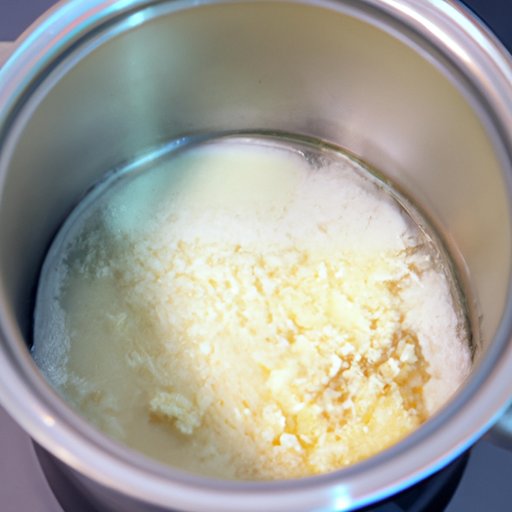I. Introduction
Butter is a staple ingredient in many recipes, but sometimes it can be difficult to incorporate in its solid form. Softening butter can be a time-consuming process, but there are a few tricks to speed up the process. In this article, we’ll discuss several methods for how to soften butter quickly.
II. Microwave Method
The microwave method is one of the most popular ways to soften butter quickly. Start by cutting the butter into small cubes or slices and place it in a microwave-safe bowl. Microwave the butter on low power, preferably in 5 to 10-second intervals. Check the butter after each interval to see if it has softened. It usually takes around 15-25 seconds to soften one stick of butter, but be careful not to melt it completely and keep an eye on it.
It’s also recommended to remove the metal foil or wrapper before microwaving butter sticks. Otherwise, it can cause sparks and fire. If you’re softening larger quantities of butter, using a microwave-safe dish with a lid is a good option to retain moisture and prevent spillage.
III. Grating Method
If you don’t own a microwave or a want a more straightforward method, the grating method is for you. Place your cold butter on a plate and use a cheese grater to shred it. The smaller pieces will soften more easily and blend into your recipe without clumps. Grating is ideal for making pie crust, biscuits, and pastry dough.
It’s pivotal to cover the butter with a wrapper or parchment paper while grating to keep it from melting in your hands. Also, ensure your grater is clean, dry, and free from rust that can contaminate butter.
IV. Pound or Smash Method
Another easy way to soften butter quickly is by using the pound or smash method. Place the cold butter in a large plastic bag, seal it, and then pound it with a rolling pin or meat tenderizer to break it into smaller pieces. Try not to overdo it because the butter can easily turn into a soggy mess.
Always use a thick plastic bag that won’t tear or leak and make sure the bag is firmly sealed to prevent splashes. Reminding you of using a gentle hand, as the butter can easily spread and make a mess in your kitchen if pounded excessively.
V. Boiling Water Method
The boiling water method is another quick way to soften butter that requires a little heat. Start by boiling some water in a pot, and place the cold butter in a separate metal or glass bowl above the pot. The heat from the boiling water should soften it within around 2-4 minutes.
Remember only to let the steam and heat soften the butter and keep it at a distance from direct water exposure. It’s also essential to select a heatproof metal or glass bowl not to crack in high-temperature conditions, and you should use oven mitts or kitchen tongs when handling the bowl.
VI. Oven Method
The oven method is quick but requires you to closely monitor the butter. Preheat the oven to around 170 to 200°F, and then place cold butter on a heatproof dish. Place the dish in the oven for 10 to 15 minutes, depending on how much butter you are softening. Monitor the butter as it softens and remove promptly once it reaches the desired consistency.
It’s essential to check the butter’s progress frequently, avoid opening the oven door too frequently to retain heat and measure the temperature of the oven using an oven thermometer. Remember, let the oven warms up before placing the butter and avoid leaving it in too long as it can quickly melt or turn rancid.
VII. On-the-Counter Method
The on-the-counter method is ideal for those who plan ahead, as it requires more time. When baking or cooking is on the schedule, simply place the cold butter on a plate in your kitchen, away from direct sunlight, and allow it time to soften at room temperature. Depending on the temperature and the quantity of butter, this method can take anywhere from 30 minutes to 1 hour.
It’s crucial to keep the butter away from direct sunlight and curious pets or children. Check the butter occasionally by touching it with the tip of your finger to see when it reaches the desired consistency. On-the-Counter method is relatively safer compared to other methods, but it’s always good to practice hygiene and keep your hands and surfaces clean.
VIII. Double Boiler Method
The double boiler method requires two pots—one for boiling water, and one to place the cold butter. Fill a larger pot with an inch or two of water and bring it to a boil, then place the butter in a smaller metal or glass bowl and place it over the boiling water. The boiling water’s heat will soften the butter without direct heat exposure. Keep stirring the butter until it’s completely soft.
Make sure the water level is low enough to prevent it from touching the smaller bowl bottom, and use oven mitts or tongs to handle the bowl above boiling water. Monitor the heating source and not to overheat the butter to avoid unwanted browning or burning.
IX. Conclusion
There are many ways to soften and incorporate butter in your recipes. The microwave method is generally the quickest, while the on-the-counter method is the safest over time. When choosing a method, consider what’s convenient for you and best suits the type of recipe you’re making.
Regardless of the method, always keep in mind essential food hygiene practices and use safe and clean equipment to avoid contamination or accidents. Softening butter is a simple process, but it can go wrong if not appropriately done.
